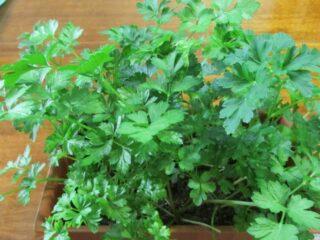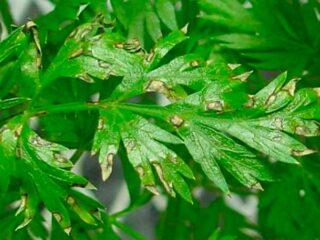Content
The difference between cilantro and parsley is difficult to notice at first glance, since their greens are very similar. These plants have other similarities, including chemical composition and beneficial properties. At the same time, both cultures have many differences, including in smell and features of use.
Is it the same thing or not?
Parsley and cilantro are different crops. They are confused because of their external similarity. Cilantro is a colloquial name, often applied only to greens. In the scientific community it is known as coriander vegetable or coriander.
What do cilantro and parsley have in common?
Both crops belong to the Umbrella family. This implies some similarities:
- carved maple foliage;
- straight stem;
- flowering in June-July;
- essential oil content.
Parsley and cilantro are popular in cooking. Both green parts and crop seeds are used. They are also used in folk medicine.
How to distinguish cilantro from parsley
There are many differences between both cultures. One of them is the peculiarities of cultivation. Parsley is cultivated as a one- or two-year plant. It produces seeds only in the second year.The difference between cilantro is that it is an annual crop. It produces seeds in the year of planting.
External differences between cilantro and parsley
A photo will help you distinguish parsley from cilantro - it clearly shows the external difference between the plants. Coriander leaves are more rounded and have a slightly wavy structure. Their shape is doubly pinnately divided. The basal leaves have long petioles, while the stem leaves have short petioles. The difference is in the stem - in cilantro it branches only in the upper part. The seeds are round, yellow-brown.
Parsley has a branched stem. The leaves are rich green and have a glossy surface. The difference is in their size, which is larger than that of cilantro. The shape is doubly pinnately dissected. There is also a difference in the shape of the seeds - in parsley they are pear-shaped.

The difference between the leaves of plants is felt tactilely - they are more tender in cilantro
The difference between cilantro and parsley is visible during flowering. Coriander has white or pink buds. The difference between parsley flowers is their greenish-yellow color.
Origin
The Eastern Mediterranean is considered the homeland of cilantro. The Romans brought coriander to Europe at the beginning of our era, and from there in the 15th-17th centuries it came to America, Australia and New Zealand. In Russia, cilantro was discovered in the 18th century, and in 1830 its mass sowing began.
Parsley is also native to the Mediterranean; it grows wild on the sea coast. It began to be cultivated in the 9th century. Unlike cilantro, it appeared in Russia earlier - in the 15th century. A century later, it began to be cultivated in our country as a spicy plant.
Smell
The photo does not convey all the differences between cilantro and parsley. One of the main points is the aroma. In parsley it is pleasantly spicy and harmonious. In contrast, cilantro smells sharper and more tart.Its lemon-pepper aroma is caused by decanal (aldehyde) in the composition.
The smell of plants is not always immediately noticeable. To strengthen it, just rub the leaf between your fingers. Cilantro smells stronger if picked before flowering.

The most obvious external difference from cilantro is in curly parsley - its leaves are smaller and very wavy.
Application
Due to its specific taste and aroma, cilantro is rarely added to salads, although its leaves are more tender. They prefer to complement hot dishes, especially meat ones, with coriander. Greens go well with pea or bean soup. Fresh leaves are used to decorate ready-made dishes and sandwiches. Cilantro as a herb is popular in Caucasian, Mexican and Pan-Asian cuisine.
The scope of application of parsley is much wider. Many people use it fresh, complementing various dishes:
- sandwiches;
- salads and cold appetizers;
- boiled fish;
- meat and soups with it;
- game;
- mayonnaise;
- potato dishes.
The French dry the washed greens and fry them in vegetable oil. It is served warm with meat and fish dishes.
In addition to greens, the seeds of both plants are used in cooking. They are less popular with parsley and are used mainly for preservation. Essential oil is also used for it, which is obtained from the fruits and leaves of the plant.
Coriander seeds have a wide range of uses; they are added to the following dishes and drinks:
- bakery and confectionery products;
- alcoholic beverages;
- canned fish;
- milk soups;
- canned stewed meat;
- sauerkraut;
- pickled fish;
- beer;
- kvass.
Chemical composition
The chemical composition of plants is different. There are differences between greens with seeds. The chemical composition of the leaves contains the same vitamins:
- A;
- K;
- E;
- ascorbic acid;
- riboflavin;
- a nicotinic acid;
- thiamine;
- pantothenic acid;
- pyridoxine;
- folic acid.
Parsley surpasses cilantro in percentage terms in almost all of the above elements. The exception is pantothenic acid and vitamin E - there are more of them in coriander greens. Another difference is the presence of biotin in parsley. There are other differences in chemical composition:
Element | Content in parsley, % | Content in cilantro, % |
Silicon | 50 | — |
Cobalt | 41 | — |
Potassium | 32 | 21 |
Calcium | 25 | 6,7 |
Magnesium | 21 | 6,5 |
Copper | 15 | 23 |
Chromium | 12 | — |
Phosphorus | 12 | 6 |
Iron | 11 | 9,8 |
Zinc | 8,9 | 4,2 |
Manganese | 8 | 21 |
Chlorine | 7 | — |
Fluorine | 5,8 | — |
Iodine | 2,9 | — |
Sodium | 2,6 | 3,5 |
Selenium | 0,2 | 1,6 |
There are also differences in the nutritional value of greens. Parsley per 100 g has:
- 3.7 g protein;
- 0.4 g fat;
- 7.6 g carbohydrates;
- 2.1 g dietary fiber;
- 85 g water;
- 49 kcal.
For cilantro, the percentage and calorie content per 100 g are different:
- 2.1 g protein;
- 0.75 g fat;
- 0.9 g carbohydrates;
- 2.8 g dietary fiber;
- 92 g water;
- 23 kcal.

It is recommended to consume no more than 35 g of cilantro and 50 g of its relative per day - exceeding the norm can harm the body
Growing rules
Cilantro needs to be sown every year. Parsley is a biennial plant. In the second year, in addition to greens, there will also be seeds.
One of the differences is the landing time. Coriander is sown in early spring or September. Due to its good frost resistance, parsley can be planted from late winter to late autumn. When growing for greens, sowing is recommended at intervals of three weeks.
Both crops are frost-resistant.Parsley can withstand temperatures down to -10 °C and winter well. When cold weather sets in, the seeds will not germinate, but will sprout next year. Cilantro is not afraid of frosts down to -7 °C, but the green mass grows actively at temperatures from 22 °C.
Both crops are best grown in sunny areas, light partial shade is acceptable. The soil should be loose, the reaction should be neutral. Slightly alkaline soil is suitable for cilantro. In contrast, slightly increased acidity is better for parsley.
Caring for both plants is the same and involves the following activities:
- regular watering;
- weeding;
- loosening.
Both crops require thinning. Usually it is carried out as the green mass is collected. If the plantings are too dense, thinning begins earlier.
When growing cilantro, fertilizing is not necessary if fertilizers are applied during digging or planting. For parsley, complex formulations are recommended, including nitrogen, potassium and phosphorus. The same fertilizers can be used for cilantro. This stimulates the growth of green mass and improves immunity.
Which is healthier: cilantro or parsley?
If we consider the chemical composition of the leaves, then parsley is healthier. It contains more micro- and macroelements and vitamins. This composition provides the following properties:
- strengthening the immune system;
- improved vision;
- antiseptic effect;
- expectorant effect;
- decreased blood sugar levels;
- normalization of the digestive system;
- acceleration of regeneration;
- regulation of metabolic processes;
- restoration of the nervous system;
- normalization of sleep;
- strengthening the walls of blood vessels and heart muscle;
- diuretic effect;
- decreased sweating;
- regulation of stomach acid levels;
- promoting the elimination of toxins and waste.

Not only green mass has beneficial properties, but also parsley and cilantro seeds
Cilantro also has beneficial properties. Some of them are similar to her relative:
- strengthening the immune system;
- toning the body;
- activation of metabolic processes;
- improving the functioning of the digestive tract;
- bactericidal effect;
- anthelmintic effect;
- removal of waste and toxins;
- diuretic effect;
- normalization of the nervous system;
- increasing potency;
- prevention of degenerative changes in the eyes;
- skin rejuvenation.
When choosing between plants, it is important to consider possible harm and contraindications. Parsley is not recommended in the following cases:
- iodine deficiency in the body;
- hypothyroidism;
- kidney diseases;
- cystitis.
Both types of greens are not recommended for women in the first trimester of pregnancy. For the rest of the period, the consumption rate is reduced to 10 g per day.
Cilantro is not recommended for use in the following cases:
- gastritis, if acidity is increased;
- cardiac ischemia;
- hypertension;
- myocardial infarction;
- thrombosis;
- thrombophlebitis;
- diabetes.
Which is better to choose: cilantro or parsley?
For weight loss with strict calculation of calories and carbohydrates, cilantro is better, although unlike parsley it contains less protein and more fat. When choosing in terms of aroma and taste, you need to focus on your own preferences.
Conclusion
The difference between cilantro and parsley lies in appearance, aroma, chemical composition, and beneficial properties. Plants have many similarities.Cilantro is an annual crop, parsley is grown for two years. They are cared for equally.








